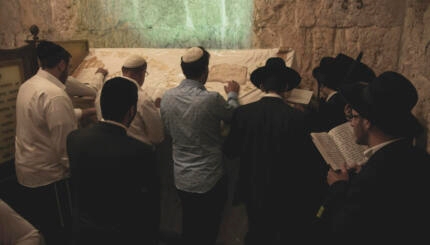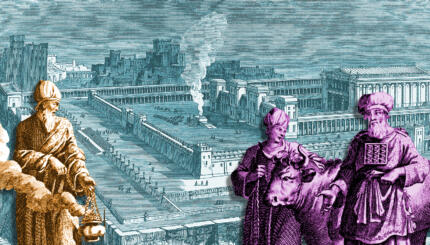Reprinted with permission from The Jews of Spain: A History of the Sephardic Experience (Free Press).
Muhammad (Like Ishmael, Arguably) Was a Merchant
Trade was fundamental to Islamic life from the outset, in large part because Muhammad had been a merchant. According to Muslim (but not Jewish) tradition, Abraham’s son Ishmael, the forefather of Islam, was a textile merchant. The quasi-global economy of Islam eventually stretched from Iberia to the Indian Ocean, as ideas and men, goods and armies, moved freely between East and West. Mobility was facilitated by early oral Islamic tradition, which regarded travel for the sake of knowledge as a venerable and pious activity that might even assure entry into Paradise. According to one source, the Prophet himself said, “Those who go out in search of knowledge will be in the path of God until they return” Or, as the traditional phrase put it, “In mobility there is blessing” (In the too, travel for the sake of learning was commanded…)
Jewish Merchants Moved Freely Throughout the Mediterranean Region
Medieval Jewish documents spanning almost a thousand years, preserved in the treasure trove known as the Cairo Geniza, show how natural it was for Jews to be on the move. Their religious persuasion was no barrier to travel, and the surrounding culture helped revive and reinforce the ancient Talmudic custom of traveling in order to learn. The Geniza documents note quite casually the frequency with which Jews also moved between Spain and Sicily, Aden and the Indian Ocean, for the sake of contracting marriages for their offspring or establishing new branches of business. Evidently it was not even unusual to make several journeys from Spain to India during one’s lifetime.
Jews preferred to travel by sea, because one does not desecrate the Sabbath by gaining mileage on the water; the requirement of halting a land caravan for a day could be extremely expensive. Moreover, the Muslims had made the sea routes eminently safe, by constructing lighthouses along the shores and introducing new, improved naval vessels; even so, ships in this era stayed fairly close to shore, and in winter, when the tides were tricky, traders took the land routes. A medieval Jewish merchant might well own a home in Iberia and another elsewhere, perhaps in Morocco or in the Near East. Thus was fashioned an overarching culture and cosmopolitan community that shared many features, exchanging new tastes and technologies along with goods and services.
With your help, My Jewish Learning can provide endless opportunities for learning, connection and discovery.
The storehouses of thousands of commercial and personal papers discovered in the Cairo Genizah indicate how remarkably free travel was in the medieval Mediterranean world. The concept of law was personal, not territorial, and a person was judged according to the law of his religious community. Genizah letters are oblivious to political boundaries as Jewish merchant families moved back and forth between rival kingdoms. To be sure, there were customs stations everywhere, but both Christian and Muslim powers seemed intent upon preserving a free-trade community in the Mediterranean…
The Era of the Merchant Scholar
Serious studies of this era have pointed out that the learned merchant was the standard-bearer of medieval Islamic civilization. The Muslim pilgrim’s standard wish was “May your hajj be acceptable, your sin be forgiven, and your merchandise not remain unsold.” Jews drew freely from this intellectual and commercial climate, as a large and influential merchant class began to rise all over the Middle East in the eighth and ninth centuries. Jewish, Muslim and Christian mercantile families dealt with each other in partnerships, and “formal friendships” characterized business relations. The bonds of friendship were solidified by marriages conducted between families all over the Mediterranean and the Indian Ocean route. The family was considered the ideal form of business partnership, with ties of blood superseding ties of marriage.
Nahrai ben Nissim, Trader and Correspondent
The Geniza collection includes over 300 letters to and from Tunisian Jewish merchant scholar Nahrai ben Nissim, a regular commuter between Tunisian and Egypt in the eleventh century. His transactions over the course of a fifty-year career (1045-96) involved merchandise from Spain, North Africa, Sicily, Egypt, Syria and India. His extremely diversified trade included almost all the staples and luxuries of the commercial world of his day: flax and silk, olive oil and spices, metals and books, jewels and chemicals, food and hides. His detailed surviving accounts reveal a man of exceptional organizational and intellectual abilities who worked in partnership with a variety of experts, but it appears that such versatility in trade was an exception. Usually, leading merchants worked closely with others who specialized in one item of commerce. The remarkable Nahrai was also a talented scholar who was honored by his peers in Egypt, Palestine and North Africa.
The international trader is a familiar figure in the genizah correspondence, for merchants were practically commuters and would casually remark about the ordinariness of long-distance trips, although a spirit of adventure also permeates many of their letters. Such business travel was commonplace in part because merchants felt that they had to protect their merchandise, in part because they believed that “one who is present sees what one who is absent cannot see.” Although the rhythm of life in all Jewish communities was determined by the religious calendar, it was also shaped by the comings and goings of their itinerant merchants. As one of the genizah correspondents writes, “The synagogue is desolate, for the Maghrebis have left.”
Early Monopolists: The Radhanites
From a ninth century account, Kitah al-Masalik wa’l Mamalik (The Book of the Roads and Kingdoms), we learn incidentally of the remarkable commercial activities of the Radhanites, a Jewish firm whose operations may have been based in Spain or southern France. Their name may derive from the Persian “knower of the way.” Very little is known about them other than the Arabic description of their routes and merchandise, from which we learn that their trade stretched across several continents with branches in many ports and commercial outposts.
Their representatives followed four distinct land and sea routes. One went northward through Europe via Prague, Bulgaria, and the land of the Khazars. Two proceeded along the Mediterranean littoral and ended in Iraq and Iran (the trip from Cordoba to Baghdad normally took a year). The fourth went by sea and land all the way to China. Generally speaking, most of the commerce agents of the Radhanites went only part of a route, making trade with colleagues who had accumulated merchandise on an adjacent leg of the whole route.
Factors specific to medieval Jewry helped the Radhanites acquire monopolies. For example, Muslims were excluded from European markets, and Christians were virtually barred form Islamic waters; only Jews could travel as commercial agents in both realms. In addition, like all Jews, the Radhanites could be assured of hospitality among co-religionists dispersed all along their transcontinental route through North Africa and Asia as well as in the European hinterlands.
Pirates!–Fostered by Holy War
The naturalness with which the medieval Jew engaged in commerce over long distances should not obscure the fact that considerable peril was involved. Genizah letters are replete with allusions to the hazards of nature and the merchant’s sense of gratitude to God for deliverance from danger. In anticipation of the ever-present threats of piracy, banditry, and assaults by the crew, merchant ships tended to sail in convoys.
Piracy, which colored all aspects of sea commerce, was a part of the continuing holy war between Islam and Christendom and was especially active near Byzantine shore and in the eastern Mediterranean in the eleventh century. So well known and feared was the pirates’ nest off the cast of Libya that merchants would write their families in relief as soon as they passed by safely.
Jews captured by pirates could count on ransom and rescue by fellow Jews in the area when they were brought to a slave market, generally deprived of all possessions including the clothes on their back. Repeatedly, communities in Cairo and especially Alexandria were summoned to redeem men and women from the hands of pirates. One fragment indicates how the Jews in Cairo were burdened with frequent requests for ransom snad had to organize collections in other communities.
Sephardic
Pronounced: seh-FAR-dik, Origin: Hebrew, describing Jews descending from the Jews of Spain.



